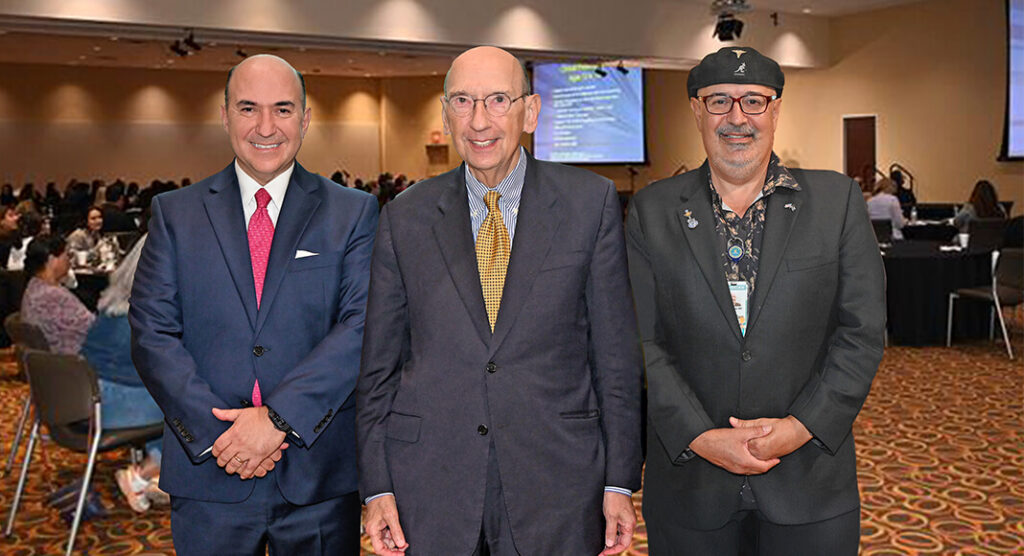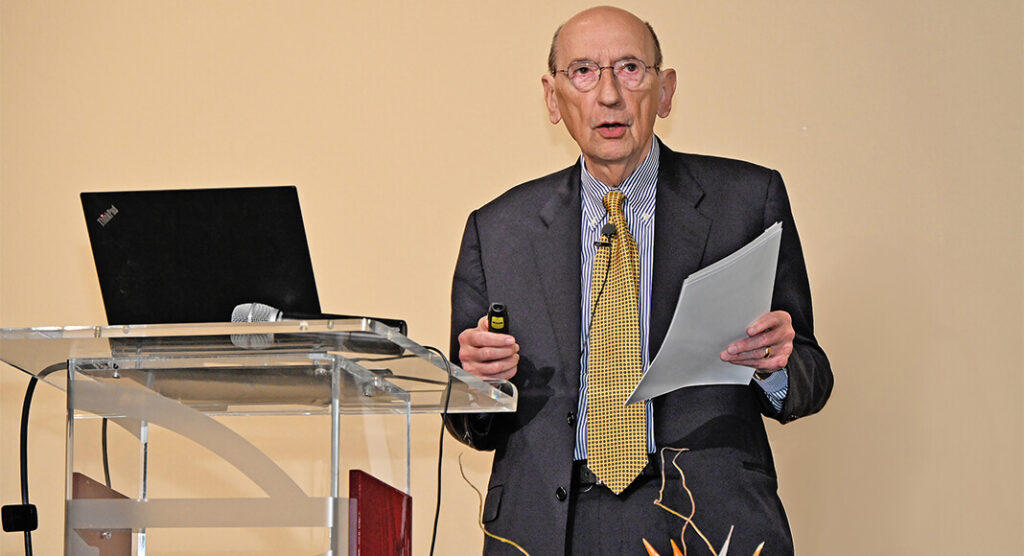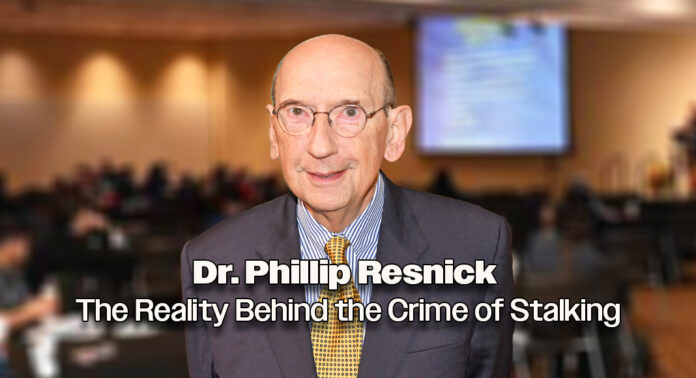Mega Doctor News
By Roberto Hugo Gonzalez
Dr. Phillip J. Resnick, a leading forensic psychiatrist with decades of experience in violence risk assessment, recently shared his insights on stalking in a lecture given at DHR Health. During his career, which has included consultations on high-profile criminal cases involving Jeffrey Dahmer, Susan Smith, Timothy McVeigh, Andrea Yates, and Casey Anthony, Dr. Resnick has spent years studying the motivations, classifications, and dangers of stalking.
“Stalking is a serious issue that affects both men and women, though women are far more likely to be victims,” Resnick explained. “For the women in the room, there is a 29% likelihood you’ll be stalked at least once during your lifetime. Men are about half that frequently.” He noted that stalking takes many forms, from unwanted communication and following a person to issuing threats and even cyberstalking, which has become increasingly common in the last 20 years.

“Rather than harassing phone calls, we now see harassing cyber communications. And what people can do online is actually quite powerful,” Resnick said. “They can gather a lot of information about you, attempt to ruin your reputation by spreading lies, and even cause others to harm you.” He recalled a particularly extreme case in which a woman rejected a man after meeting him for a single lunch. In retaliation, he hacked into her email and posted online that she wanted to be raped, providing her home address. “So, people started showing up at her home with the expectation that this woman wanted to be raped,” he said. Even after she put a sign on her door stating the message was a hoax, the cyberstalker escalated the situation by writing online that the sign was fake and that she wanted to be attacked anyway. “That man was sentenced to considerable time in prison,” Resnick said, highlighting the dangerous power of cyberstalking.
Stalking has not always been a crime. “Before the 1980s, there were crimes for harassment, but not stalking per se,” he explained. “Now, a pattern of behavior is just two incidents. So, if you tell someone, ‘Do not bother me again,’ and then they bother you twice more, that’s all you need for a pattern of behavior.”
Resnick also pointed out how stalking has permeated pop culture, citing songs like Every Breath You Take. “It turns out that Sting, who wrote that song, wrote it after he was personally stalked. But then he got 200 letters from stalkers saying that’s the greatest love song they ever heard,” he said.
Stalkers are not all the same. According to Resnick, forensic research has divided stalkers into five categories. “The first are rejected stalkers,” he explained. “This is where there was an actual relationship– often a former partner– but it could be any relationship where one person breaks it off.” These stalkers often seek both reconciliation and revenge. “Here’s an actual quote from a case I saw: ‘My actions were to force myself to be important in her life, even though it was in a negative way. I once thought, forget about me, bitch. I’ll make you remember me forever.’” He noted that rejected stalkers frequently have abandonment sensitivity and a history of assault.

The second type of stalker is the intimacy seeker. “They are pursuing intimacy with the object of their affection and see this person as their true love. The majority of these individuals have an erotomanic delusion– a false belief that another person, usually someone of social higher status, is in love with them,” Resnick said. One of the most famous cases was that of John Hinckley Jr., who became obsessed with actress Jodie Foster and attempted to assassinate President Ronald Reagan to impress her. Dr. Resnick explains, “This is an example, not of an erotomanic delusion, but of simply unrequited love.”
He continues, “Now, let me give you an example of how persistent these stalkers can be. I treated a woman, and this was some years ago when we were allowed to give people longer passes than today.”
Dr. Resnick recounts, “This woman loved her obstetrician. The obstetrician was married, had no interest in her, but she was convinced otherwise.” He elaborates, “Now, think about what a setup it is for a male obstetrician. He puts his hands in the private parts of a woman, and then at the end of the experience, he gives her a baby.” Dr. Resnick emphasizes, “And what could be more of a setup for a woman to develop potentially erotic feelings toward such a man?”
Dr. Resnick continues, “This woman was convinced that her obstetrician loved her. She would show up at his office, show up at his home, and was driving him crazy.”
Dr. Resnick further explains, “He reported her to the police, and she was involuntarily hospitalized. I treated her; shehad an erotomanic delusion.” He describes his approach, saying, “I treated her with antipsychotics. She appeared to get better, and I decided to give her a 12-hour pass on a Saturday to see how she would do.”
Dr. Resnick recounts what happened next: “She went immediately to the obstetrician’s home, rang the doorbell, and the obstetrician came to the door and said, ‘You, you scum of the earth. I hate your guts. Don’t darken my doorstep again. Get out of here,’ and slammed the door.”
Dr. Resnick explains, “So she came back, and I asked, ‘How did your pass go?’ She told me about the experience, and I asked, ‘Well, did this convince you that this man doesn’t love you?’” He concludes, “And she said, ‘No. What could he do? His wife was home,’” adding, “This is a nice example of how no amount of confrontation with reality is going to change an actual delusional belief.”
The third category is the incompetent stalker. “These individuals may have low intelligence or feel narcissistically entitled,” Resnick explained. “They may just see a woman they like and say, ‘Hi, I like you. Let’s f***.’ Believe it or not, some women are put off by this directive.” He noted that incompetent stalkers tend to abandon their targets if threatened but often move on to another victim.
Resnick himself has been stalked by a woman who fits the fourth category: the resentful stalker. “She developed a delusional idea that I was having voodoo sex with her. She would call me and say, ‘Because you had voodoo sex with me, I’m going to keep calling you for the rest of my life.’” These stalkers often have paranoid personalities and want to frighten their victims.
The final category is the predatory stalker, who is preparing for a sexual attack. “These men take pleasure in the sense of power produced by stalking,” Resnick said. “They stalk in the same sense that a fox stalks a rabbit.” These individuals engage in behavioral rehearsal, such as following women to their homes to assess the possibility of breaking in. “These are the most dangerous types of stalkers,” he warned.
The likelihood of violence varies among stalkers, with rejected stalkers and sexual predators being the most dangerous. “The number one factor for predicting violence is a former intimate relationship. If there was a former intimate relationship, the risk of physical assault goes up eleven-fold compared to other types of stalking,” he said.
Restraining orders are not always effective. “One-half to two-thirds of restraining orders are violated,” Resnick explained. “If someone has a minor investment in a woman, like after two dates, a restraining order might make him stop. But if a man has been married to a woman for 35 years, a piece of paper isn’t going to stop him. In fact, 22% of cases get worse after a restraining order is issued.”
Mental health professionals are at greater risk of being stalked than the general public. “One in six mental health professionals will be stalked in their professional lives,” Resnick said. “Female therapists are twice as likely as non-clinicians to be stalked, and male therapists are five times more likely. This is often due to erotic transference from patients.” Some stalkers try to ruin reputations, such as a female patient who accused her psychiatrist of sexual misconduct. “She even went to the police with dried semen, claiming it belonged to the psychiatrist. DNA confirmed it was his, but an investigation revealed she had rummaged through his trash to find discarded underwear with semen on it,” he recounted.
When asked how stalking victims should respond, Resnick stressed that all contact should be avoided. “Each contact is intermittent positive reinforcement,” he explained. “For example, when someone calls your phone, just hearing your voice on a voicemail message is reinforcing. The best strategy is to keep your old phone without answering it and get a new number that only close friends know.”
Police intervention must be carefully considered. “Any event that humiliates the stalker—like receiving a restraining order—can increase the risk of violence,” Resnick warned. “Interventions must be weighed carefully.”
Summing up, he emphasized three key points: “Former intimate partners are the most dangerous stalkers. Clinicians should always obtain consultation when they are being stalked. And getting a restraining order sometimes increases the risk of violence.”
With stalking laws evolving and digital harassment on the rise, understanding the psychology behind stalking is more critical than ever. As Resnick warned in closing, “Remember—every step you take, every move you make, I’ll be watching you.”
See related story:










